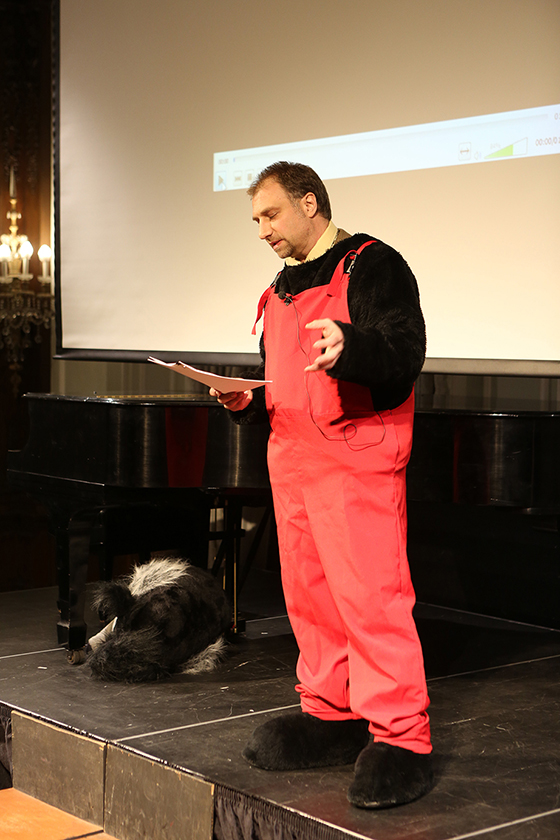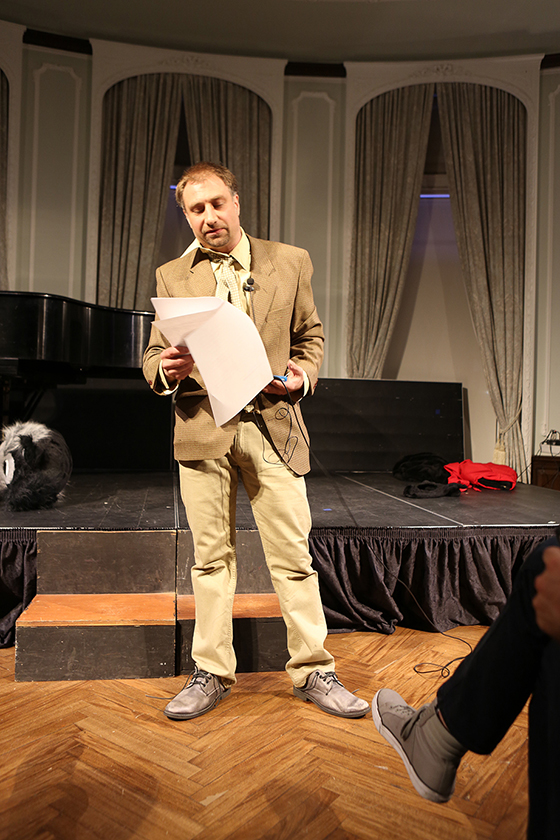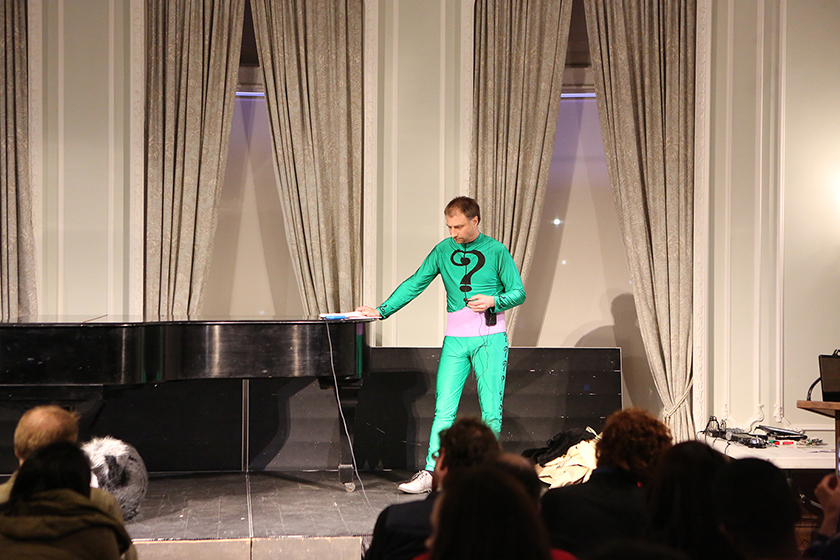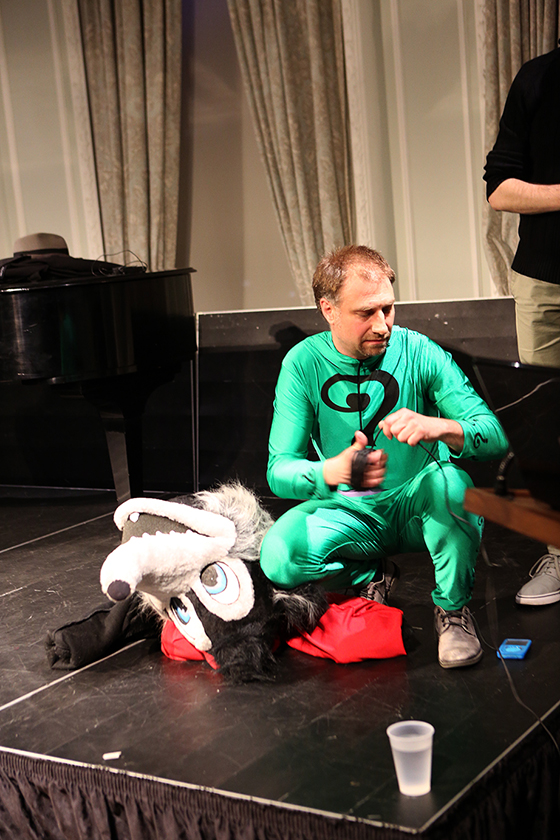SELECTED WORKS |
The following is a transcript from a paper delivered at A Night of Philosophy, a free event that hosted 62 international philosophers and 12 artists on April 24, 2015 from 7pm to 7am simultaneously at the French Embassy and The Ukrainian Institute on New York City’s Upper East Side. I was invited as an artist, and I chose the subject of the shape-shifting character Leshonkii, of Ukrainian, Russian and Slavic folklore, to adapt to the site of the Ukrainian Institute. The logical shape to shift into was that of a philosopher. I delivered my lecture at 3:50am to a full concert hall with people standing around the perimeter. Included are my costume notes and visual and audio interruptions. I have no video documentation of the event.
(Enter: Wolf – wearing costume, holding head under arm. Bowl head onto stage to make thud)
Sorry about this, but I had this other gig. I’ll introduce my topic, and then show some images while I change out of this outfit. And then I’ll begin my lecture.
INTRODUCTION
Now, I’ve collected some images of a Leshonkii. The young are spotted more easily as they’re still learning their trade. While I show these, I’m going to change out of this outfit and then begin my lecture. If any of you feel the need, now would be the time to take off your clothes and reverse them and swap your shoes. (images of Leshonkii in the wild: 1:51 min.)
(costume change: from Wolf to philosopher with clothing and shoes reversed)
EXPLAINING CHILBLAINS “And as he walked, beneath his feet, were chilblains.”2 (1 audio: 00:02 sec.) Aristotle used this joke from an unknown drama as the earliest example of the Incongruency Theory of the Philosophy of the Comic. Does anyone get this joke? Does anyone know what a chilblain is? (2 audio: 00:04 sec.) Like laughter in a foreign language, we often miss the joke. With Aristotle’s we don’t know the context. Chilblains, we learn, are sores resulting from frostbite. But why is this man’s pain funny? In order for humor to succeed, it must surprise us. Immanuel Kant said, “laughter is the result of an expectation that ends in nothing.” I would disagree that chilblains are nothing, and to the walker, they are something, but their appearance would have surprised the audience. So working backwards, we can translate the joke. The walker is likely a king, prophet or the brightest philosopher himself or someone from whom below his feet the earth might tremble. Instead, he has blisters, the plight of any peasant. It’s actually a Bergsonian joke: “Any incident is comic that calls our attention to the physical in a person, when it is the moral that is concerned.”3 Now having understood the context, we can laugh properly. So here it is again. “And as he walked, beneath his feet, were chilblains.” (3 audio: 00:04 sec.)4
FROG TICKLERS (4 audio: 00:07 sec.) EB White said, “Humor can be dissected, like a frog can, but the thing dies in the process and the innards are discouraging to any but the pure scientific mind.”5 (5 audio: 00:02 sec.) Explaining humor, like chilblains, is painful to humans, too. And by now, White’s joke opens most discussions of the Philosophy of the Comic, so it’s exhausted by repetition. In sketch comedy the magic number is three, three escalating beats. Two is not enough and four is too many. If I add a fifth, well, that’s when you throw vegetables. Yet there are pure scientific minds among us, philosophers especially, who can’t help poking at frogs. So we proceed by reminding ourselves that “even gynecologists fall in love.”6 (6 audio: 00:10 sec.) After laughing, some of us want to know how and why something was funny. Umberto Eco said, “The Problem of the Comic had the advantage of always having caused embarrassment to those philosophers who tried to define it.”7 He meant that every philosopher who has tried, failed to get it completely, starting from Plato and Aristotle8 through Freud and Bergson and up to John Morreall and Simon Critchley. We have three primary theories: Superiority, Incongruency and Relief, but no grand unified theory, and this is cause for embarrassment. Philosophers, like scientists and mathematicians, like to seek the One, Neo or God that will solve everything. Part of the problem is that the Comic is divided into many family resemblances – as Wittgenstein might call them. One theory can’t apply to humor, laughter, jokes, puns, derision, satire, irony, parody, wit, physical comedy and tickling. So each philosopher tackles one at a time and the Comic, at the top of the taxonomy, has trouble holding all the banana peels. (7 audio: 00:02 sec.) Aristotle gave us a starting point, but he also gave us false leads. He and Plato gave Thomas Hobbes a pad from which to launch a Superiority Theory, a sort of stepping on the neck of the person we’re laughing at. He also gave us chilblains, which Kant, Schopenhauer and Kierkegaard developed into an Incongruency Theory.9 And he told us that after exactly 40 days, a baby could laugh.10 But babies have since proved him wrong. (8 audio: 00:02 sec.) And this suggests that literacy plays a role. With chilblains we are illiterate of the context, so we miss the point. And the Rule of the Comic differs from the Rule of the Tragic, and again I’m invoking Umberto Eco.11 With tragedy, he explains, the laws are constantly reinforced. At every step, the audience is reminded of the rules, so when they are broken, we witness the character flaws and see the suffering we are prepared for. This builds literacy. With Comedy, by contrast, the rules are presupposed because we know them well. The Rule of the Comic is to never announce the rules, so that when a break occurs it is incongruous to our expectation. For the Comic to work, one must follow a recommendation by Wittgenstein, “He must […] throw away the ladder after he has climbed up it.”12 (9 audio: 00:02 sec.) Aristotle also suggested that man, alone among the beasts, has the capacity to laugh. And this, too, has been called into question. But more on that later. Now, Eco gave Aristotle a way out of embarrassment. He said, “As a thinker, Aristotle was lucid enough to decide to lose a text in which he had not succeeded in being as lucid as he usually was.”13 (10 audio: 00:04 sec.) Philosophical lore has it that Aristotle was working on a Poetics of the Comic, but that book is now lost. Many philosophers continue the search because in Western cultures, without Aristotle, we lack confidence. If Aristotle were smart enough to lose a book he couldn’t wrangle, then who are we to try? In fact, Eco included Aristotle’s lost book as a character in The Name of the Rose. And there is a good essay by David Colosi, entitled the “The Comic in Eco,”14 where he analyzes this character, and I’ll only mention it here. Connecting a chain of Eco’s thoughts, Colosi points to a third remark in which Eco says, “Not one of those who have written on [the philosophy of] the Comic could be called a comic writer.”15 He argues that Eco, as a Semiotician and literary theorist16 who also writes novels, has come closest to fixing this. Though he doesn’t directly call Eco a “comic writer” – he’s not David Sedaris, Tina Fey or Chris Rock – Colosi points out the greater chance of success if the writer is more than an explainer. But what kind of success are we after? James Feibleman, in his In Praise of Comedy anticipates Eco’s remark. He says, “Comedy belongs to the realm of intrinsic value, but the examination of comedy is part of logic,” so “the analysis of comedy can be no more funny than the analysis of water can be wet. Is the physicalness of the physical object destroyed by the measurement of its weight, mass, density and dimensions?"17 Certainly, the analysis of water cannot be wet, except metaphorically, and a box is no less a box once we measure it. But just as Kant and Hegel wrote reasonably within Reason, Heidegger was as he wrote about Being and Sartre existed while writing about Existentialism, so can a written work about the philosophy of the Comic be funny. When I was in high school, I got shingles, and my doctor told me a joke. He said, “When the shingles jump your spinal cord, you’re going to die.” (11 audio: 00:04 sec.) I didn’t get it, so he explained that since shingles run along nerves, they can never jump to another nerve, so I had nothing to worry about. My response, being illiterate of this medical fact, was “Fuck you.” Philosophical analysis and comic writing both operate through language games, so no spinal cord separates them. They share a nerve. Tickling, you might argue, is an exception that doesn’t involve language: a philosophy of tickling can’t be ticklish.18 This, I’ll grant you, but it is possible for both to elicit laughter. And laughter inspired by tickling is a result of literacy. A baby, after however many days, must understand that mother means no harm with her fingers. Peter McGraw, an Empirical Humor Researcher, has named his grand unified theory the Benign Violation Theory.19 For the mother’s tickling to be a benign violation, the baby, in its defenselessness, must know tickling to be harmless. That’s Wittgenstein’s ladder again. In the final analysis, nothing requires philosophical writing to be non-humorous. So in challenge to White’s quip that analysis of humor kills it, can we, rather than dissect the frog, try to tickle it instead? And here I will break the rule and forecast my goal. Ludwig Wittgenstein is attributed to saying, “A serious and good philosophical work could be written which consisted entirely of jokes.”20 I’m a fan of mathematical statements, and those that Kurt Gödel could appreciate interest me even more. And I call this margin note by Wittgenstein the Fermat’s Last Theorem for mathematicians of the Philosophy of the Comic. Andrew Wiles solved his problem, so there’s hope for ours. By announcing my goal, you could say I’m executing my joke. (That’s a bit of gallows humor for you). We know that explanation can be painful, and if you’ve read Rebecca Solnit’s essay “Men Explain Things To Me,” you know what I mean. Mansplaining is no laughing matter, even though we gave it a funny name. But there is something funny about explanation. After hearing her pompous host explain to her about “another” book on Eduard Muybridge that he read about in the New York Times, ignoring the interruptions of Solnit’s friend who repeatedly corrects him in that he is, in fact, describing Solnit’s book, she leaves this uncomfortable situation in this way: “Being women, we were politely out of earshot before we started laughing, and we’ve never really stopped.”21 (12 audio: 00:11 sec.) So there’s a link between explanation and laughter, and now it’s just a matter of harnessing it in our attempts to explain why we laugh. Alexander Herzen wrote, “It would be extremely interesting to write a history of laughter.”22 And Mikhail Bakhtin wrote a history of Rabelaisian laughter, which is extremely interesting, but it is also very unfunny. He discusses bodily humor in the time of Rabelais with terms like “scatological discharge” and “the lower bodily stratum.” Compare this to Deleuze and Guattari’s Anti-Oedipus, where we see and smell shit, sputum, sperm, amniotic fluid spilling out of the sac and kidney stones, milk the baby throws up when it burps and sunbeams in the anus of Judge Shreber. Their work, like that of Rabelais, “breathes, heats, eats, shits and fucks.”23 So, surely, philosophy can be funny. Also taking up Herzen’s challenge, Barry Sanders wrote Sudden Glory: Laughter as Subversive History. It is extremely interesting, and funny at times. But again, Bakhtin, Sanders and Deleuze and Guattari are not comic writers. So why, recalling Fiebelman’s objection, would we expect their books to be funny, too? Possibly the problem is in Eco’s idea of a comic writer. Who does he expect to write this book? Jerry Seinfeld? (13 audio: 00:01 sec.) Comedians know how and why comedy works, and like Aristotle, they are lucid enough to lose the explanation. So if the philosopher is too outside the joke and the comic too inside it, who then can solve this proof? My answer agrees with Colosi’s in his essay on Eco. Possibly the artist and novelist can meet the challenge by remaining inside the joke and outside the joke simultaneously through a manipulation of characters. But to understand why requires more explanation. I feel a case of the chilblains coming on. (14 audio: 00:02 sec.) As I’ve said, philosophy likes grand unified theories, and its preferred path to Oneness is dualisms. Several are pertinent. The first is the laugh vs. the smile. When we hear something funny, we involuntarily laugh, but when we understand something that is funny, we knowingly smile. The second, related to the first, is the naïve vs. the critical. The first time we hear something funny, we are willfully naïve. We walk into a result we didn’t expect. If we take a second critical look, we can achieve the smile. This again comes from Eco. He discusses it in terms of naïve and critical readers or first and second level readers. The first level reader of a novel finds out what happens. She doesn’t ask questions but waits to see how it ends. The second level reader reads again wanting to know how she was lead to that end. These readers are White’s pure scientific minds.24 The creative vs. the scientific and the aesthetic vs. the serious are rather arbitrary dualisms. Michel Houellebecq has written serious scientific novels, and Dasein is pretty creative. Derrida, too, was a great poet. And Eco’s work conflates these dualisms, writing novels, on the one hand, and theories of Semiotics, on the other, while uniting theory with practice in the same nerve. Entertainment vs. Art also follows this pattern. And now this is the third time that I’ll mention David Colosi, who, in his book Towards a Three-Dimensional Literature, Part 1, tests the theory that the role of Entertainment is to give us what we know and want and the role of Art is to give us what we don’t know and don’t want.25 Similarly, Edward Said said, “Least of all should an intellectual be there to make his or her audiences feel good: the whole point is to be embarrassing, contrary and even unpleasant.”26 The role of the artist is the same, according to Colosi, in that she gives people what they don’t know and don’t want, and once they starting knowing it and wanting it, it loses its status as art and becomes entertainment. And this is why Ad Reinhardt called a museum a tomb because Art goes there to die. I can only introduce Colosi’s theory here, but it leads me to the last dualisms I’ll draw your attention to. That is the amateur vs. the expert, which concerns the credibility the speaker has to discuss his topic. The tension increases when someone, say, chooses to discuss Freedom of Speech, but her record shows that she is not an expert on the practice.27 Irony withstanding, we would rather hear the amateur speak because we can learn more from contradiction than perfection. And wasn’t it Kierkegaard who told us, “Wherein there is contradiction, the comical is present”?28 And in this way, along with Rebecca Solnit, we can laugh at the pompousness of others and never stop, in the hopes of appreciating the social value of exposing our own flaws. The expert, like a work of art that we know and want, like the deteriorating Last Supper that no longer looks like what it stands for, resides in a tomb.29 The amateur can deliver the surprise and contradiction that makes us laugh. And finally I step on the ground where the artist meets the philosopher. It is on this stage that you can hang me from the gallows. Most artists, faced with an audience of the world’s leading philosophers, would approach the podium saying, “I’m not getting on that thing, it looks dangerous.”30 But here, maybe you’ve begun to ask yourself, “Is professor Leshonkii, who has been clowning wisely,31 a comic writer?” (15 audio: 00:08 sec.) In closing, I want to return to Aristotle’s idea that laughter separates us from the other beasts. We continue to believe this idea and attribute it to him. But, as Barry Sanders points out, Aristotle said this as a margin note, and others after him32 preserved it as a barrier we’re too proud to poke. In fact, when Aristotle introduces this idea, it is buried in a statement on tickling. The Philosopher said, “That man alone is affected by tickling is due firstly to the delicacy of the skin, and secondly to his being the only animal that laughs. For to be tickled is to be set in laughter, the laughter being produced by such a motion as mentioned of the region of the armpits.”33 I get the chilblains just reading that. Recently science amateurs Jad Abumrad and Robert Krulwich did a RadioLab episode on Laughter. They challenged this notion of man’s exclusive ability to laugh when they interviewed Neuroscientist Jaak Panksepp.34 Now, as you might have guessed, I have another gig after this, so I’d like to play you an excerpt of their show while I change. (16 audio: 2:39 mins.)
CONCLUSION Just before I go, I have two riddles. Q: Is it possible to tickle frogs in a way that won’t kill them? (17 audio: 00:07 sec.) And the second: Q: What happens when a tree falls in the forest, and no one is there to hear it? (18 audio: 00:28 sec.)
NOTES 1 Leshii also took the blame for babies smothered in their sleep;
WORKS CITED
WORKS CONSULTED
|
|
|






